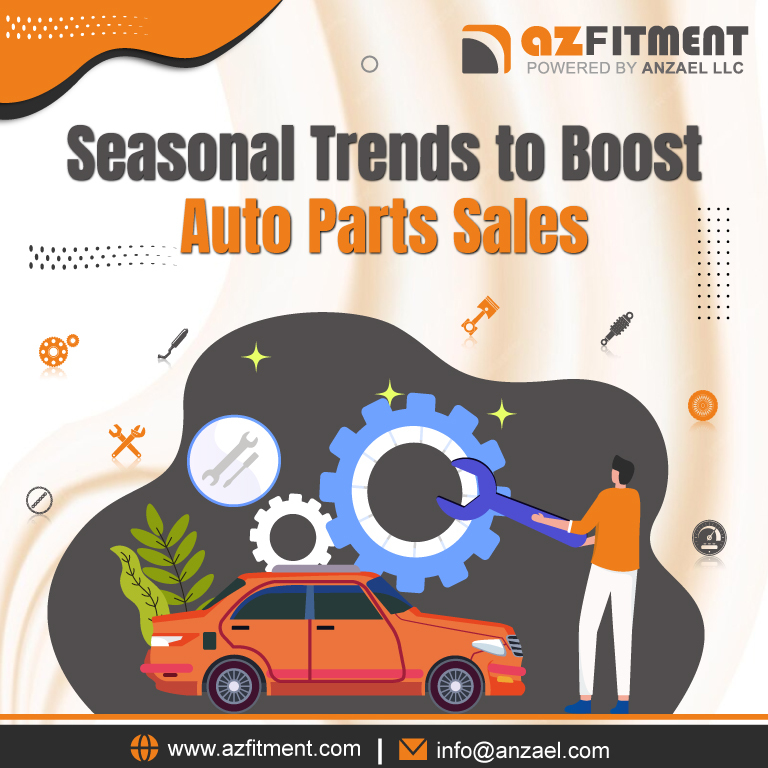When it comes to selling auto parts online, tapping into seasonal trends can significantly impact your bottom line. For U.S.-based automotive parts manufacturers, understanding seasonal patterns in consumer behavior provides an opportunity to elevate sales during peak demand periods. By aligning your inventory, marketing, and promotions with these trends, you can position your business for success while increasing revenues effectively.
This blog will explore seasonal strategies for auto parts, offering actionable tips to optimize your business and keep your sales consistent throughout the year.
Why Seasonal Trends Matter in Auto Parts Sales
Auto parts have varying demand levels depending on the season. For instance:
- Winter: Increased demand for snow tires, windshield de-icers, and battery replacements.
- Summer: Higher sales for cooling systems, air filters, and travel-related accessories like roof racks.
- Spring/Fall: Seasonal maintenance boosts sales for oil filters, brake pads, and suspension components.
By identifying these trends, your business can plan inventory, adjust marketing campaigns, and maximize sales during peak seasons. Adopting seasonal auto parts sales strategies ensures you’re meeting customer needs at the right time, keeping your business competitive.
Benefits of Seasonal Planning
- Better Inventory Management: Stock up on high-demand items and reduce warehouse costs for off-season products.
- Improved Customer Satisfaction: Offering timely solutions strengthens trust and loyalty.
- Boosting Auto Parts Revenue: Strategic promotions during peak demand can drive profits.
Seasonal Strategies to Maximize Auto Parts Sales
To get the most out of seasonality, you need to combine marketing efforts with data-driven insights. Here’s how to do it:
1. Forecast Demand Using Past Data
Analyze historical sales data to identify seasonal trends. Know which products peak at certain times and stock them accordingly. Supplement this with insights into:
- Local weather patterns
- Regional preferences (e.g., snow tire demand in colder states)
2. Targeted Marketing Campaigns
Create tailored campaigns for each season to attract your audience. For example:
- Winter Campaigns: Highlight cold-weather essentials such as antifreeze and snow chains.
- Summer Promotions: Offer discounts on cooling system repairs or recreational vehicle parts.
Use channels like SEO, email newsletters, social media, Meta ads, and Google Ads to reach your audience. Remember to integrate customer-oriented messaging focused on safety and preparation.
PRO TIP: Utilize geo-targeting to make campaigns more relevant. For example, promote rain-resistant wiper blades in states with frequent spring showers.
3. Seasonal Bundling
Bundle items that customers often buy together based on seasonal needs. Bundling increases the average order value while simplifying decision-making for buyers.
Examples of Seasonal Bundles:
- Winter Safety Kit (snow chains + battery charger + windshield de-icer)
- Summer Travel Pack (roof rack + tire inflator + phone holder)
4. Offer Seasonal Discounts
Promotions and seasonal deals can drive both traffic and conversions. Use timed offers like:
- Black Friday sales for general parts
- Post-winter clearance for overstocked cold-weather items
Place emphasis on availability and urgency to encourage customers to act quickly.
5. Educate Your Customers
Help buyers understand the importance of seasonal maintenance and upgrades. Blogging or creating videos about topics like “Winterizing Your Car” or “Must-Have Accessories for Summer Road Trips” establishes your brand as a trusted advisor and draws attention to related products.
Customer Education Ideas:
- Share tips on extending tire life during extreme weather.
- Create a checklist for end-of-season vehicle maintenance.
6. Capitalize on Market Trends
Stay ahead of auto parts marketing trends by adopting new tools and platforms. For instance:
- Use social proof (customer reviews, testimonials) to highlight product reliability.
- Boost eCommerce sales by submitting to marketplaces like Amazon, eBay with the help of aftermarket experts.
- Incorporate AI tools to suggest seasonal products dynamically based on browsing history.
These innovative strategies allow you to capture larger market segments during every seasonal window.
Essential Tools for Seasonal Success
Success in maximizing auto parts sales requires leveraging tools and technology. Consider using:
- Inventory Management Software: To align stock levels with projected demands.
- CRM Platforms: To segment your audience for better-targeted promotions.
- Analytics Tools: To monitor campaign performance and adjust strategies in real-time.
Utilizing these tools ensures your seasonal campaigns remain efficient, organized, and profitable.
Quick Checklist for Seasonal Auto Parts Marketing:
- Use demand forecasting to prepare inventory.
- Launch location-specific campaigns on social media platforms.
- Plan promotions around major holidays (e.g., Memorial Day, 4th of July).
- Stock small, high-profit essentials like air filters and spark plugs for year-round sales.
By streamlining operations and implementing these strategies, even smaller manufacturers can effectively compete.
Measuring Seasonal Strategy Success
The final step in leveraging seasonal trends is evaluating how well your strategies performed. Track these metrics to identify areas for improvement:
- Sales Growth: Compare seasonal revenue YOY (year-over-year).
- Customer Acquisition Costs (CAC): Examine how efficient your promotional efforts were.
- Product Sell-Through Rate: Evaluate inventory turnover to avoid over- or under-stocking.
By keeping track of performance, you’ll refine your approach, making future seasonal strategies even more impactful.
Final Thoughts
Capitalizing on seasonal strategies for auto parts is a game-changer for businesses seeking consistent growth. By aligning promotions, inventory, and customer engagement with seasonal demand, automotive parts manufacturers can see a significant boost in auto parts revenue.
Implement the tips shared above, and you’ll be well-positioned to stay ahead of the competition while meeting the needs of your customers at the right time, every time.
Start planning for the next season today, and watch your profits rise steadily throughout the year!
If you need help with fitment data submissions to marketplaces, feel free to contact us now.


